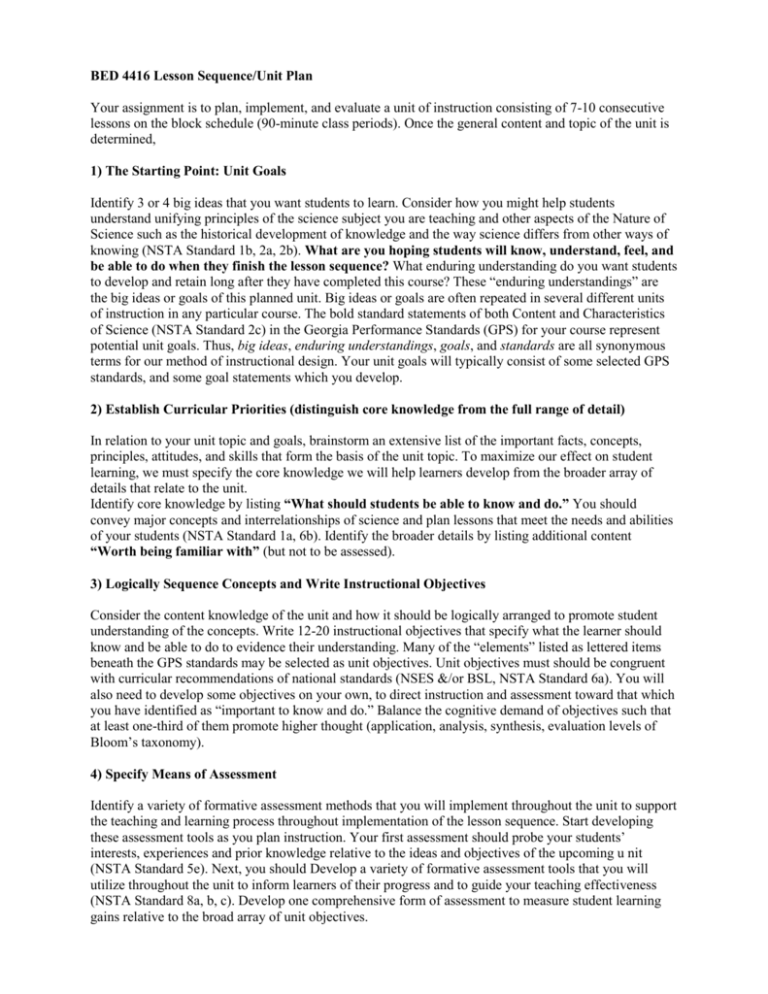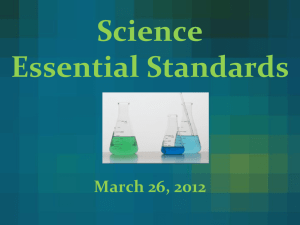Unit Plan
advertisement

BED 4416 Lesson Sequence/Unit Plan Your assignment is to plan, implement, and evaluate a unit of instruction consisting of 7-10 consecutive lessons on the block schedule (90-minute class periods). Once the general content and topic of the unit is determined, 1) The Starting Point: Unit Goals Identify 3 or 4 big ideas that you want students to learn. Consider how you might help students understand unifying principles of the science subject you are teaching and other aspects of the Nature of Science such as the historical development of knowledge and the way science differs from other ways of knowing (NSTA Standard 1b, 2a, 2b). What are you hoping students will know, understand, feel, and be able to do when they finish the lesson sequence? What enduring understanding do you want students to develop and retain long after they have completed this course? These “enduring understandings” are the big ideas or goals of this planned unit. Big ideas or goals are often repeated in several different units of instruction in any particular course. The bold standard statements of both Content and Characteristics of Science (NSTA Standard 2c) in the Georgia Performance Standards (GPS) for your course represent potential unit goals. Thus, big ideas, enduring understandings, goals, and standards are all synonymous terms for our method of instructional design. Your unit goals will typically consist of some selected GPS standards, and some goal statements which you develop. 2) Establish Curricular Priorities (distinguish core knowledge from the full range of detail) In relation to your unit topic and goals, brainstorm an extensive list of the important facts, concepts, principles, attitudes, and skills that form the basis of the unit topic. To maximize our effect on student learning, we must specify the core knowledge we will help learners develop from the broader array of details that relate to the unit. Identify core knowledge by listing “What should students be able to know and do.” You should convey major concepts and interrelationships of science and plan lessons that meet the needs and abilities of your students (NSTA Standard 1a, 6b). Identify the broader details by listing additional content “Worth being familiar with” (but not to be assessed). 3) Logically Sequence Concepts and Write Instructional Objectives Consider the content knowledge of the unit and how it should be logically arranged to promote student understanding of the concepts. Write 12-20 instructional objectives that specify what the learner should know and be able to do to evidence their understanding. Many of the “elements” listed as lettered items beneath the GPS standards may be selected as unit objectives. Unit objectives must should be congruent with curricular recommendations of national standards (NSES &/or BSL, NSTA Standard 6a). You will also need to develop some objectives on your own, to direct instruction and assessment toward that which you have identified as “important to know and do.” Balance the cognitive demand of objectives such that at least one-third of them promote higher thought (application, analysis, synthesis, evaluation levels of Bloom’s taxonomy). 4) Specify Means of Assessment Identify a variety of formative assessment methods that you will implement throughout the unit to support the teaching and learning process throughout implementation of the lesson sequence. Start developing these assessment tools as you plan instruction. Your first assessment should probe your students’ interests, experiences and prior knowledge relative to the ideas and objectives of the upcoming u nit (NSTA Standard 5e). Next, you should Develop a variety of formative assessment tools that you will utilize throughout the unit to inform learners of their progress and to guide your teaching effectiveness (NSTA Standard 8a, b, c). Develop one comprehensive form of assessment to measure student learning gains relative to the broad array of unit objectives. 5) Plan Instructional Activities Plan instruction as a series of lessons, each directed toward 2-3 objectives per day. Structure each lesson plan to include objectives and summary statement of teacher / student activities aligned with assessments. In daily lesson plans, briefly comment on your use and student use of technology to support learning (NSTA Standard 5d). Specify safety protocols followed for all lessons (NSTA Standard 5f, 9 a, b, c, d). Vary instructional methods to offer individual, small group, and whole group engagement in developmentally appropriate scientific inquiry (NSTA Standard 3 b, 5 a, c). BED 4416 Unit Plan Grading Rubric 1. Your assignment is to plan, implement, and evaluate a unit of instruction consisting of 7-10 consecutive lessons on the block schedule (90-minute class periods) based on the Georgia Performance Standards (GPS) for the course you will teach. 2. Collaborate with your co-teaching partner in developing this lesson sequence. If your placement does not allow for a co-teaching partner, you will share ideas with other solo-teaching candidates, work more closely in collaboration with your mentor teacher, and receive additional assistance from your university supervisor. 3. Despite the collaborative nature of unit planning, the goal is for you to have the opportunity to implement the unit as lead teacher in your adopted class for the methods practicum. 4. Final revisions of the unit will be based on your personal reflection on teaching, student assessment data, and feedback offered by co-teaching peers, mentor teacher, and university supervisor. Criteria Inadequately Adequately Strongly Met Met Met Accomplished Comments Beginning Developing 0-1 2 3 Unit Goals and “Big Ideas”: Specify 3 goals or enduring understandings that will be emphasized in this instructional unit. Selected from the GPS Science Content Standards as well as those relating to the Nature of Science & Habits of Mind (Characteristics of Science Standards). (NSTA Standards 1b, 2a, 2b, 2c) Establish Curricular Priorities: Generate an extensive list of important facts, concepts, attitudes and skills related to the unit topic. From this list, decide “What students should be able to know and do.” and what is merely “Worth being familiar with.” (NSTA Standards 1a, 6b) Logically sequence content: Arrange the content knowledge of the unit in a sequence that facilitates concept development of the learners. Write instructional objectives that x2 specify what the learner should know and be able to do to evidence their x2 x2 understanding Instructional objectives should be aligned with GPS and NSES (NSTA Standard 6a). Analyze prior knowledge: Via a preassessment administered at start of unit, or periodic assessments before several lessons in the unit, document efforts to identify & work with students’ prior knowledge relative to unit objectives. (NSTA Standard 5e) Formative Assessment: Develop a variety of formative assessment tools that you will utilize throughout the unit to inform learners of their progress and to guide your teaching effectiveness (4 to 6). (NSTA Standard 8a) Summative Assessment: Develop one comprehensive form of assessment to measure student learning gains relative to the broad array of unit objectives. (NSTA Standards 8b, 8c) Plan Daily Lessons with Structure: For each day of instruction, specify objectives, activities and means of assessment. Summarize use of technology and safety protocols. (NSTA Standards 5d, 5f, 6a, 9a, 9b, 9c, 9d) Plan Daily Lessons with Variety: Vary instructional methods to offer individual, small group, and whole group engagement in developmentally appropriate inquiries. (NSTA Standards 3 b, 5a, 5c) x2 x2 x2 Total: _______ / 30










